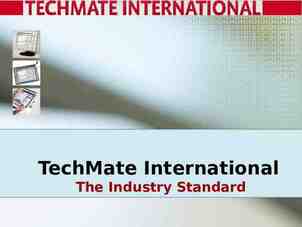The Idaho Model of Distilled Spirits Distribution Citizen Owned
27 Slides6.83 MB
The Idaho Model of Distilled Spirits Distribution Citizen Owned for the Benefit of All 1
Historical Perspective – The WHY The 18th Amendment established Prohibition in the U.S. in 1920. In 1933, the 21st Amendment repealed the 18th Amendment and ended Prohibition. Regulation of beverage alcohol distribution granted to the states. All states have some form of regulation. 22 jurisdictions, including Idaho, chose a system of more government involvement.
A Quiz Q: How many jurisdictions have beverage alcohol “Control”? Some clues KY – home of the American Spirit, Bourbon. Wine and liquor not in grocery or C-Stores. CT – Wine and liquor not in grocery stores. Sunday sales just approved. CO – 3.2 beer only available in grocery and C-Store. IN & TX – No Sunday Sales FL – No liquor in grocery or C-Stores. MA – No liquor in Bay State grocery or C-Stores These are all “Open” or license or “Non-Control states. A: 51 The POINT: Government in every jurisdiction controls beverage alcohol in some form or fashion. WHY? Because beverage alcohol is NOT like any other product. 3
4
MISSION The mission of the Idaho State Liquor Division is to provide control* over the importation, distribution, sale, and consumption of distilled spirits; curtail* intemperate use of beverage alcohol; and responsibly optimize the net revenues to the citizens of Idaho. Article III – Section 24 & 26 – Idaho Constitution
VISION The vision of the Idaho State Liquor Division is to be the most respected and highest performing purveyor of distilled spirits in the USA.
Idaho Overview A Dedicated Fund Agency 66 State retail stores, 106 contract stores Full-service distribution center receives and ships one million cases annually 203,400,000 in Sales in FY2017; Forecast 211,000,000 in FY2018 FTP 220 plus up to 140 temporary associates Distributions to Cities, Counties, Substance Abuse Treatment, & General Fund: FY2017 73,300,000 FY2018 77,200,000 FY2018-FY2027 forecast 925,000,000 7
ISLD Performance (Dollars in millions, cases in thousands) Sales Net Income Net Profit Margin 9-Liter Cases 2005 2010 2015 2017 (Projected) 95.2 32.2 137.6 46.3 179.0 65.7 203.4 75.6 211.0 77.0 33.8% 33.6% 36.7% 37.2% 36.5% 673 896 1,050 1,141 1,165 4.9 13.1 24.9 29.0 30.9 12.4 8.3 9.0 9.6 9.7 16.5 33.8 25.8 47.2 30.5 64.4 34.7 73.3 36.6 77.2 2018 Distributions*: General Fund Other State Programs Cities & Counties Total Distributions * Statutory Methodology for Distributions: Section 23-404, Idaho Code 8
Consumption of Distilled Spirits (Annual Gallons per Capita) Idaho Consumption is 20% Less than Open States 1.75 1.65 1.70 1.65 1.53 1.55 1.45 1.42 Open States United States Idaho Idaho (less Wash.) 1.35 1.25 Ser Source: Distilled Spirits Council of the United States (DISCUS) & U.S. Census Data 9
Outlet Density Spirits Outlets Per 100,000 Residents (21 years and over) Control States Idaho 24 16 License States 50 Availability really does matter quite a lot in terms of drinking, problem drinking, under-age theft, alcohol-related harms and other problems. The Centers for Disease Control and Prevention Community Preventive Services Task Force recommended reducing or limiting the growth of alcohol retailers as a way to "reduce the harms associated with excessive alcohol consumption." This comprehensive, peer-reviewed study can be found at www.cdc.org. Source: Alcohol Research Group; CDC
Outlet Density – Beer vs. Spirits 270 Beer Spirits 240 Shares per 100,000 people 210 180 150 120 90 60 30 0 AL ID IA ME MI MS NH NC OH OR PA UT VT VA WV WY MC MD Control States 11
Outlet Density – Beer vs. Spirits Beer 120 Spirits Shares per 100,000 people 100 80 60 40 20 0 AZ CA CO FL GA IL IN MD MA License States MN MO NJ NY TN TX WI 12
Idaho Statute: Title 23 – Chapter 4 2% surcharge on all sales goes to drug and family courts Amount of remaining distribution is determined based on available cash and working capital needs: – In FY2017, 50% to State: 5.65 million to state fixed-fund accounts Remainder to general fund – In FY2017, 50% to Cities & Counties 60% allocated to cities based on sales (90% to cities with liquor stores, 10% to cities without liquor stores) 40% allocated to counties based on sales 13
“Control” States Control States x 14
About State-Operated Models Nationwide, 21 jurisdictions utilize a control model Control jurisdictions average 13% less consumption than open states. – 1.5 gallons/capita in Idaho (Washington is est. 7% of volume net 1.4) – 1.5 gallons/capita in all control states – 1.7 gallons/capita in open states Idaho earns 77/gallon in revenue, while control states average 75/gallon. Open states earn 42/gallon, but private sector profit margin increases retail price. Source: Distilled Spirits Council of America (DISCUS) 15
The Idaho Model - Benefits Lower per capita consumption Fewer alcohol related deaths & lost work days Safer roadways & lower crime Better selection for consumers & licensees Bailment inventory (vendor owned) Predictable revenue for local jurisdictions and lower taxes for Idaho residents Source: National Alcohol Beverage Control Association & Alcohol Justice 16
The Idaho Model – Why it Works Fewer, but conveniently located, retail outlets offering spirits Limited, but convenient, store hours Uniform, fair, supplier-based pricing All revenue generated remains in Idaho ISLD does not advertise Improved compliance vs. private sector Source: National Alcohol Beverage Control Association & Alcohol Justice 17
Our Strategic Goals Our performance benchmarks aim to ensure the Division responsibly optimizes net revenues without implementing strategies that encourage consumption. To that end the Division strives for: Distributions to stakeholders grow faster than ( 6.7%) Dollar Sales which grow faster than ( 6.5%) 9-Liter Case Sales which grow faster than ( 4.3%) Adult per capita consumption ( 2.2%)
19
Citizen Owned for the Benefit of All Distributions are largely a result of average wholesale and retail mark-up that would exist regardless of who distributed and sold distilled spirits. ISLD utilizes a private, Idaho-owned transportation company ISLD leases space from the private sector for our 66 retail outlets and contracts with 106 private business owners in smaller communities Limited but convenient outlet density leads to lower, responsible consumption Our profits stay in Idaho for the benefit of Gem State citizens Over 900,000,000 will be distributed to all Idahoans over the next decade Washington State: An experiment in our own backyard 20
Impact of Washington I-1183 Costco’s 22 million Initiative 1183 dismantled (“privatized”) Washington’s state-run liquor enterprise effective June 1, 2012. Outlet density offering spirits increased from 328 outlets to over 1,800. Grocers and big box Retailers ( 10,000 sq. ft.) were the main beneficiaries to the detriment of other retail channels. State remains whole on revenues. No change to taxes Did NOT get government out of the business Addition of distributor and retailer mark-up and fees Higher Prices Unhappy Consumers 21
Oregon: Oregon grocers want to sell liquor, file privatization measure Source: KATU By Jonathan J. Cooper Associated Press Dec 16, 2013 A group led by Oregon grocery stores filed initial paperwork Monday that could lead to a ballot measure asking voters whether to privatize liquor sales. The organization called Oregonians for Competition said in a statement that it's filed five proposed initiatives and will select one to move forward with. The initiatives differ in details, but all would allow liquor sales in stores that already sell beer and wine and are at least 10,000 square feet. Existing liquor stores would be allowed to stay open, and some smaller shops like wine specialty stores would be able to sell liquor. "The initiative will end the state's outdated liquor store monopoly system and allow distilled spirits to be sold safely and responsibly in retail stores just like they are in most other states, while at the same time strengthening our state's liquor laws," Melinda Merill, a spokeswoman for Fred Meyer Stores, said in a statement. Oregon's liquor-regulation system was created 80 years ago after Prohibition was lifted. Liquor can be purchased from the state at only about 200 licensed stores. The OLCC sets prices and pays liquor-store owners, known as agents, a percentage of their sales. In the last fiscal year, which ended in June, the commission distributed just over 200 million to state, county and city governments as well as treatment programs for mental health and substance abuse. 22
Citizen Owned for the Benefit of All Remember all citizens, not just consumers. Abstainers 35% Regular Drinkers 51% Source: Health Statistics for US Adults: National Health Interview Survey 2010 Infrequent Drinkers 14% 23
Citizen Owned for the Benefit of All Shelf prices are determined by suppliers. 98% of the net proceeds are generated from our competitive wholesale and retail markup and sales tax that’s applied to all retail purchases in Idaho. They keep other taxes low and come from the willing not the coerced. The structure in Idaho has been in place for 80 years and is efficient, convenient, continually updated, and a benefit for all Idahoans. 24
Citizen Owned for the Benefit of All Liberalizing the system will result in increased taxes(1); increased prices to consumers(2); increased outlet density and hours of availability(3); and increased risk to public health and safety(4). Source: as indicated 25
Sources (1) – Increased Taxes Washington Liquor Control Board (WLCB): - 3.77/liter bottle tax and 20.5% liquor sales tax, both applied at retail checkout - NEW: 10% fee for distributors; 17% fee for retailers (2) – Increased Prices to Consumers (WA State results from I-1183) Reuters, June 2012: - 10%-30% or more depending on brand (3) – Increased Outlet Density (WA State results from I-1183) Washington Liquor Control Board (WLCB): - 400% (4) – Increased Risk to Public Health and Safety Published in the American Journal of Preventive Medicine April 2012 (CDC – Centers for Disease Control and Prevention) - Effects of Alcohol Retail Privatization on Excessive Alcohol Consumption and Related Harms 26
Thank you Our Annual Reports can be found at: http://www.liquor.idaho.gov Jeffrey R. Anderson - Director [email protected] 208-947-9402 27
































